If you are new here, don’t forget to check our Discord Channel. it’s free for everyone!
If you want to check out more of my Dredge content, check this link.
Introduction
Dredge’s sideboard is nothing spectacular in the combo world. Its main use is to neutralize opponents’ hate cards. The secondary purpose is to do what regular sideboard cards should do – answer opponents’ key cards or strategies, but it’s more of collateral damage than the main reason why the card is here.
When building and using a sideboard in Dredge, it’s also important to understand how sideboarding affects the deck’s main gameplan. Dredge is an aggro-combo deck that’s designed to get a critical mass of threats early in the game. It’s also so dedicated to its main gameplan that we can’t pivot into something different after game one. We are simply forced to do our thing over and over again. That’s why our sideboard should always prioritize answering to the opponent’s hate first. If you feel that the hate is covered, or you can just overpower it with what you have in the maindeck, then you can start thinking about hating the opponent’s strategy. There’s also a huge threat of oversideboarding. In my opinion, in Dredge it’s better to not side in something that’s maybe good, but you are not 100% sure than to add something that’s not absolutely necessary. Sure, sometimes you’ll lose to a random Leyline of the Void that somehow got into the sideboard of the deck that usually doesn’t play it. But the fear of it shouldn’t force you to always side in three Wear//Tears. In a long run, you’ll lose more games to not doing your thing when the engine is going than to random hate you didn’t expect to face.
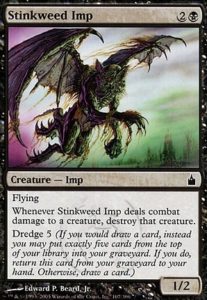
Because Dredge is so focused on its own gameplan and its curve is filled with plays (for those who haven’t read the first part of the primer: turn two Reunion, turn three Ox is the goal) answers have to be as cheap as possible so they won’t slow down our goldfish time too much. They also shouldn’t require you to keep the mana open all the time. Cards like Spell Pierce or Flusterstorm may look ok in theory, but in practice, you’ll always want to develop your gameplan and tapout for an enabler instead. They also work terribly with Ox of Agonas. Playing something that stays on the battlefield or has an impact immediately is a better approach. The ideal example is Leyline of Sanctity – it’s for zero mana, so if we have it, we won’t lose a tempo at all and will be able to deploy our threats while being protected from various graveyard hate options. Sadly, nearly every other answer is for more than zero mana, so you can expect to be slowed down thanks to them. Still, you should prioritize the ones played for one mana. Firstly, because they can be cast on the first turn, before our first opportunity to cast a Reunion effect, and secondly because of the possibility of turn three answer + a Reunion effect.
Top options for Dredge’s sideboard
Dredge is in a good place in terms of what is possible to be added – thanks to being a rainbow deck, we can choose the best options for the deck and not think too much of colour requirements. Deckbuilding restrictions also aren’t a problem at all.
Gemstone Caverns
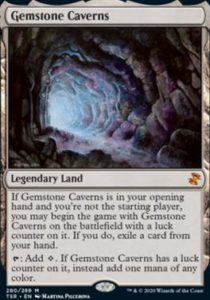
A unique card that deserves to have a separate segment. It’s an old tech that got a second life thanks to deckbuilding changes that have been made after MH2. Side it in when you are on a draw, as simple as that. This card isn’t widely played because it has a lot of restrictions attached to it. You can’t focus on card advantage and have a good way to use your extra mana early in the game, so the opponent won’t be able to keep up. Luckily for us, Dredge can make it work:
- Dredge is one of the few decks in current Modern that does not care how many cards are in your opening hand. As long as you have two lands total and any way to start the engine, you should be fine. Starting with five or four cards is a common thing. That’s why it’s a good trade for us to exile one cards from a hand (most likely, it won’t be used anyway) to get a tempo advantage when we are on a draw.
- Since Gemstone Caverns enters the battlefield before the game starts and the first turn in the game is the opponent’s, it’s important to have enablers that will fully benefit from the fact we have this one extra mana source on the turn ‘zero’. Loam Dredge didn’t have any meaningful options. Nowadays, we have Otherworldly Gaze, Darkblast and seven/eight Reunion effects that can tempo the opponent out when played on turn one.
- Dredge nowadays uses the rainbow aspect of the Gemstone Caverns with a luck counter very hard. Having it smooths the mana significantly.
There’s one more requirement that makes this card good in some decks. If the deck can handle playing a grey land without abilities on the play, so it could give you some value when playing on the draw, then Gemstone Caverns can be maindeckable. Archetypes like Rhinos, Calibrated Blast or Prison Tron are good examples of that. They don’t have to go all in and let the opponent start the game even if a dice roll was won. Sadly, Dredge is not in this group of decks – a land that doesn’t produce red mana is a disaster for us. That’s why I recommend playing it only in the sideboard, so you’ll have access to it only when you are on a draw.
The last question is what you should side out when you add Caverns. I won’t give you one, golden rule, but at least I can write down a few guidelines:
- In most situations, I tend to cut one Steam Vents (assuming I’m playing two copies) and one fetchland.
- If I’m playing vs an aggressive deck and I don’t need white mana for sideboard options, I cut one fetchland and one Mana Confluence.
- Vs aggressive decks when I also want white mana, I cut Mana Confluence and Steam Vents.
Cards that protect our gameplan
Your sideboard should be able to deal with the most commonly played types of hate. Ideally, you should have something for artifact one-shot hate (Relic of Progenitus, Tormod’s Crypt, etc.), interaction that’s hidden in the opponent’s hand (Endurance, Countermagic, etc.), other problematic permanents (Dauthi Voidwalker, Sanctifier En-Vec), and sometimes enchantment static hate (Leyline of the Void or Rest in Peace). I’m sure you’ll be able to find the best possible answer for each of these problems. The trick is how to pack answers into a sideboard made of fifteen cards and have enough copies of a needed card to draw it often enough to matter. The solution is to play wide answers that will cover many different types of hate. For example, Thoughtseize can deal with both Endurance and Spell Pierce, while also being an out to Rest in Peace or Sanctifier En-Vec if the opponent has them and we are short on more dedicated answers.
Portable Hole
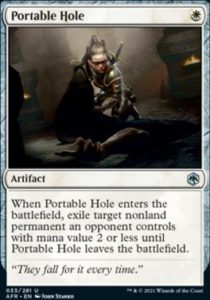
It’s the best catch-all answer we have access to (at least for now). It can deal with nearly all of the permanent-based hate cards we care about: Dauthi Voidwalker, Unlicensed Hearse, Rest in Peace, Sanctifier En-Vec, Grafdigger’s Cage, and one-shots like Relic of Progenitus, Tormod’s Crypt, etc. The biggest upside compared to other, more specific answers is that it’s rarely a dead card. If the opponent doesn’t have hate, it’s quite likely you’ll find another relevant target – a mana dork, Ragavan, opponent’s engine cards, etc. The flexibility of what can be exiled with it is a strong reason to play it. But the most important one is that it costs only one mana. Like I said many times – having a good mana curve in Dredge is very important. It would be even better if it had Flash, but we can’t have everything. In practice, casting Portable Hole will sometimes cost you some of a tempo loss, but at least not in every scenario. Turn two Hole + Otherworldly Gaze/Tome Scour or turn three Hole + Reunion are the lines you should be looking for. This type of double-spelling is something that the other previously played white removal spell – Prismatic Ending – can’t do.
Sorcery speed is not its only problem though – Portable Hole stays on the battlefield, so it can be destroyed later on. That’s why if you expect to play against decks with a lot of disenchant effects or with both Teferi, Time Raveler and Rest in Peace, then maybe playing Prismatic Ending and paying more, but dealing with the hate for good is a better thing to do. But overall, I would most of the time choose a cheaper answer.
Wear//Tear
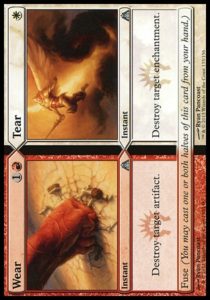
Wear//Tear has one role in Dredge’s sideboard – it’s here to destroy enchantments, mainly Leyline of the Void. In the past, Nature’s Claim was played in this slot. Wear//Tear won the competition because nowadays Dredge has more white than green mana sources. Giving four life to the opponent is also more problematic since the deck is more tempo oriented than before. If you expect that black Leyline is somewhat popular in your expected metagame, I recommend having at least three copies of Wear//Tear, just for it. The biggest problem is how to predict when it’s the time to be prepared and when you can ignore the problem and add other useful cards instead. There aren’t any golden rules for this – just analyze the metagame and if other graveyard decks aren’t too popular, so they would feel they can ignore graveyard decks a bit. If you feel that graveyard strategies are not on players’ radar, feel free to cut Wear//Tears.
There are also other targets than just Leyline. Urza’s Saga is a big one. Sigarda’s Aid and Dryad of the Ilysian Grove are fine too. Sometimes you’ll be able to steal a game with dealing with less than ideal targets like Leyline Binding or Underworld Breach, but it’s a collateral damage. Wear//Tear can also deal with artifacts, but you shouldn’t consider it as a go-to response to for example Relic of Progenitus or Unlicensed Hearse. Paying two mana for an answer is not where you want to be. Still, sometimes casting Wear will happen to be good, so keep in mind you can do it. Don’t forget about the ultimate value option: Fuse! Using this mode can happen quite often vs artifact-based Urza’s Saga decks like Affinity or Hammer.
Thoughtseize
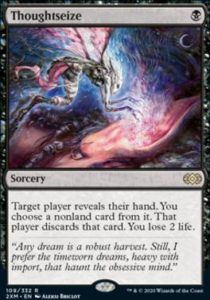
A solid catch-all answer to most of the things you can encounter. Good vs. every form of hate that hides in the opponent’s hand – Endurance is a great example of that. Discarding cheap counterspells like Flusterstorm or Spell Pierce or at least forcing the opponent to use them, so our turn two Reunion could resolve is a powerful move too. It’s also a reasonable answer to otherwise game-ending hate effects like Dauthi Voidwalker, or white exile effects – Sanctifier En-Vec and Rest in Peace. In fact, it’s the best possible answer to them since it prevents us from losing what we would already have in the graveyard. Sure, sometimes they’ll have two copies in the opening hand or topdeck another one, but that’s Magic.
The biggest upside for discard is how nicely it fits our curve. Starting from turn two we ideally want to play our enablers, so having a way to get rid of the opponent’s hate card on turn one is huge. What’s even better, it never truly misses. If the opponent doesn’t have a hate card, you can just grab their best card from hand and just slow them down. This plan is used vs. combo decks when Dredge’s best chance to win is to have turn one Toughtseize into a good flip from turn two Reunion. That’s why you shouldn’t switch Thoughtseize into Inquisition of Kozilek, even if discarded cards very often cost three or less mana. There are still Primeval Titan, Yawgmoth, Scapeshift, Goblin Charbelcher, and other expensive cards that are worth to be dealt with.
When you should have Thoughtseize in your sideboard? In my opinion, it’s correlated to the popularity of Endurance. If it’s played everywhere, I opt to rely more on Leyline of Sanctity. But if opponents’ hate is more diversified (for instance if currently played Yawgmoth list has only one Endurance and three Unlicensed Hearses), or there are just enough decks with spell-based hate or gameplan (Creativity and UW Control are good examples), I’m more into playing discard.
Leyline of Sanctity
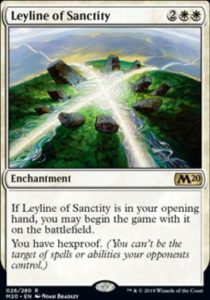
In my opinion, it’s the most powerful effect in Dredge’s sideboard and from a theoretical perspective – it fits ideally into the deck. The fact it costs zero mana is huge. It’s the only protection effect that doesn’t affect our goldfish time. It also requires the opponent to side in answers not to the graveyard, but also to enchantments, or at least change the sideboard plan just because it can happen is great. As a result just the fact that Leyline can be in your opening hand forces the opponent to make suboptimal decisions. Sadly, there are also a few problems attached to the nature of the card.
The card obviously has weaknesses. An elephant in the room – you must have it in the opening hand to make it work. Dredge doesn’t draw many cards from the top anyway (we prefer to Dredge instead), so the chances to draw it as a dead card are smaller compared to other decks in the format. Even if it happens, you probably won’t care that much because Dredge doesn’t care that much about card quality – all that matters is if the engine is going. Another interesting tendency is that Wizards started using different wording on new cards, so instead of targeting ‘target opponent’, so Leyline could stop it, they went for ‘each opponent’ instead. So technically, they don’t target, even if there is only one around (thank you, Commander). Cards like Soul-Guide Lantern, Kaya’s Guile or Ashiok, Dream Render are good examples. It may look like Leyline could be good against them, but it’s just not true. The last major obstacle that’s hard to overcome is the fact that more and more catch-all removal cards can deal with any form of nonland permanents or are attached to other, often maindeckable effects. Cards like Leyline Binding, Teferi, Time Raveler, or Boseiu, Who Endures are widely played and can deal with Leyline of Sanctity easily.
When Leyline shines? It’s the best response to player-targeting graveyard hate. Add it to your sideboard when you expect a lot of this type of hate from the opponents’ side and when there’s not that many ways to deal with a turn zero Leyline slam. The most important one to think about is Endurance. For me, the popularity of this card for a given week is my main reason to play or abandon Leyline of Sanctity as an anti-hate strategy. There are also other hate pieces that can be stopped by Leyline: Nihil Spellbomb, Tormod’s Crypt, Ravenous Trap, Bojuka Bog, etc. It also works vs Burn, Valakut options, discard, and some Mill effects, but it’s more of a side effect than its main purpose of being in the sideboard.
Ancient Grudge
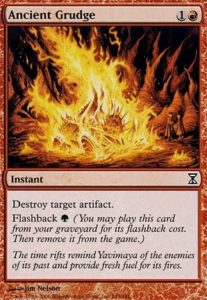
The effect may not look that great, but all that matters is its flashback ability – the fact it works from the graveyard makes it extremely powerful. It’s one of the very few sideboard options that works well with our main gameplan. So instead of hoping to draw a sideboard card in the opening hand, you can do what the deck is designed for and eventually, you’ll find the Shatter you need. It usually forces the activation of graveyard hate cards like Relic, or Tormod’s Crypt. It’s also a fine way to deal with Unlicensed Hearse. In some match ups it can be used to attack the opponent’s gameplan, not their hate. Vs. Hammer for example, destroying Shadowspear is often a game-winning move. Dealing with an Ensnaring Bridge, Amulet of Vigor, Aether Vial, etc. is a nice bonus.
The biggest problem of Ancient Grudge is its flashback casting cost. The deck in its current form is already very ambitious in terms of coloured mana – heavy on red with three splashes. It’s all good when you draw one of your eight rainbow lands. The problems start when you have to rely on shocks and fetchlands. The deck often works only on two lands and all nongreen colors are more needed than green. Stomping Ground in game one will be a worse Mountain and we just can’t afford to play even a regular basic because there’s a need for multicoloured sources. Green will be used only post sideboard, when Grudges are sided in and that’s why I came to the conclusion that if I want to have Ancient Grudges in the sideboard, I should add Stomping Ground to the sideboard as well and think about them as one package. Some would say that it’s wasting slots, but in my opinion, having much better mana in every single game you play is worth it. Still, the cost in terms of occupied sideboard slots is big and I recommend going for Ancient Grudge + Stomping Ground only if you expect to see a lot of artifact decks, mainly Hammers – it should give you a lot of percentages in the matchup.
Ray of Revelation
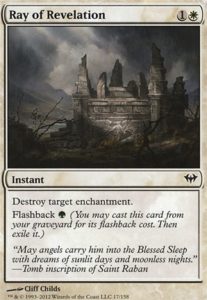
Ancient Grudge for enchantments. It looks cool in theory, but in practice, there aren’t enough good targets for it. What’s more important – the most problematic enchantment played (Leyline of the Void) won’t be affected by the flashback ability. It’s also quite hard to catch Rest in Peace with it – this would require having Ray in the graveyard and keeping green mana up all the time, so you could answer to the RiP’s trigger of exiling graveyards. And of course, there’s a problem with access to green mana. Because of these reasons I rarely play this card and I use it only if I expect to see a lot of enchantments (for example different Urza’s Saga decks).
Lightning Axe
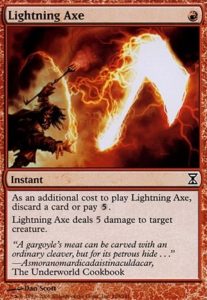
It’s the best point removal spell Dredge has access to. It’s good at dealing with hatebears and regular creatures that threaten to tempo us out. Lightning Axe is so good in Dredge because it also acts as an enabler – as long as the opponent gives us a target of course. The ability to play it on upkeep means that it can restore the broken Dredge chain before the draw. It can also enable tricks with discarding in the response to triggers on the stack. Lightning Axe does not see as much play as before MH2 because there aren’t that many decks with cheap creatures we want to kill. And vs. currently played creature decks, other sideboard options are more important, or their creatures are X/1, so they can be killed with Darkblast. The effect is powerful though and in certain metagames, for example with a lot of UR Prowess, or Goblins, it will be a way to go.
Cards that attack opponents’ strategies
Sometimes we have the luxury of playing sideboard cards that are used to stop what opponents are trying to do. Because we usually don’t have more than four slots for these effects, they are filled with powerful cards that can end the game by themselves. For example – Leyline of the Void vs. Living End or Deafening Silence vs. Storm. Remember that you are not force to play a three or four off of the same card. Going for a bunch of one-offs can also be quite effective in Dredge. This route will give you two different advantages. The first one is an obvious one – sometimes you’ll be lucky enough to have it in the opening hand and win before the game starts. The second advantage is more tricky – sideboard cards will often make the value even if you show it only as a milled card while dredging. The opponent won’t know if you play a single copy of dedicated hate or a full playset. After you showed them your hate, they will have to respect it anyway. Showing the opponent that you have access to a powerful hate card that requires a very specific action from the opponent will force them to sideboard in an unusual way. As a result, for game three, the opponent presents a worse version of their deck, with three or more most likely dead cards to stop your lucky one-off.
Let’s check useful options:
Leyline of the Void

Very narrow, but powerful response to other graveyard decks. It’s better if no one expects it. If the opponent knows that you have it, they can side in answers or change the plan (for instance Murktide players can side out Murktides, DRCs and rely more on Ragavan, Ledger Shredders and planeswalkers). There’s also one more problem – if both you and your opponent have Leyline of the Void in the opening, Dredge is still disadvantaged. We are the most graveyard-centric deck in the format and if we can’t abuse it, our cards are quite bad on their own. So for example, if you and your Living End opponent have your hate, you are more likely to lose. That’s why I first think about answers to the opponents’ hate and then maybe add Leylines to the mix if I have free slots to I don’t expect the opponent to have Leylines on their own. I tend to play leylines when other graveyard decks are not interested in playing it. The sweet spot is to have at least one since the first Leyline is the best Leyline.
Chalice of the Void
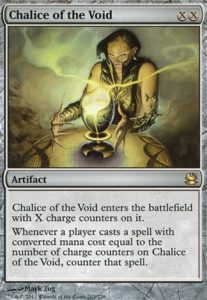
The main idea is to play Chalice of the Void for zero. It’s good vs Cascade decks, Underworld Breach (without the ability to cast zero cmc spells over and over, they can’t mill themselves and cast Thassa’s Oracle for the win), and to some extent Amulet (Chalice counters Summoner’s Pact). This line of attack is especially good in Dredge because it doesn’t interfere with our mana curve. Chalice can also be good on the play vs decks that heavily rely on one drops, for example, Hammer. Sure, it will counter our Darkblasts and Gazes, but the opponent should suffer more. Still, it’s more of a one-trick, than a real strategy in a match up.
Pithing Needle
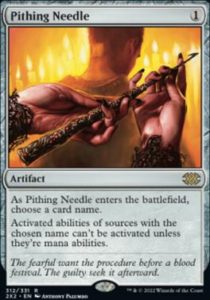
The card is both good at stopping some graveyard hate cards and problematic combo pieces or planeswalkers. While you can name Relic of Progenitus or Nihil Spellbomb, I don’t recommend siding Needle in the blind vs. decks that don’t have other relevant cards to name. It’s a viable addition vs. strategies that both have grave hate with activated abilities and rely on planeswalkers or activated abilities of other nonland permanents. Eldrazi Tron with Relics and Karn, the Great Creator would be a good example. It’s also good at stopping random combo decks: Yawgmoth, Belcher, Oops, Underworld Breach etc.
Conflagrate
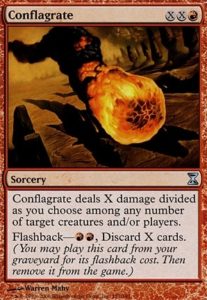
I can imagine some weird, tribal-centric metagames when I would like to play a copy in the side. In these match ups, Dredge can shift into a ‘control’ deck and every piece of removal is needed. Conflagrate works from the graveyard, so it can be useful. If you already play one copy in the maindeck, I don’t recommend playing more in the sideboard.
Deafening Silence

Quite narrow, but also a very powerful way to stop storm-style combo decks. Being for one mana is relevant because of the mana curve. That’s a game-changer compared to other options like Damping Sphere. Good vs Neobrand, Storm, Ad Nauseam, Underworld Breach, Belcher and other fringe combos. Sadly not that good vs Cascade decks because of Shardless Agent being a creature.
Alpine Moon
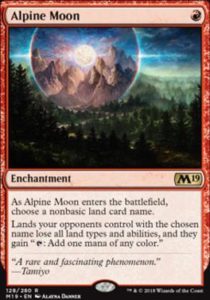
the cheapest way to say “no” to all Big Mana strategies. It looks ok vs Tron strats and it’s a beast vs Urza’s Saga. I can see it being playable in some weird metagames, but usually, it’s not worth wasting slots for this while sideboarding.
Force of Despair
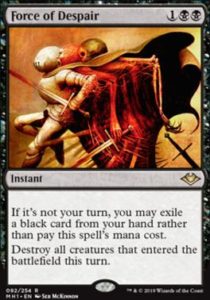
A narrow option to wipe the opponent’s board when they don’t expect this type of effect at all. It’s considered playable because of how good it works with Dredgers – at first, you get one from your graveyard to hand and then use it as fuel for Force. What’s also important – we want to cast it after we cast a Reunion, so losing a black card won’t be a huge deal (unlike in the case of Grief, when we want to cast discard before we go for Reunion spam). I can see it being good vs Amulet and maybe vs Living End, but it will work only once and it’s possible to play around it or make it not impactful at all.
